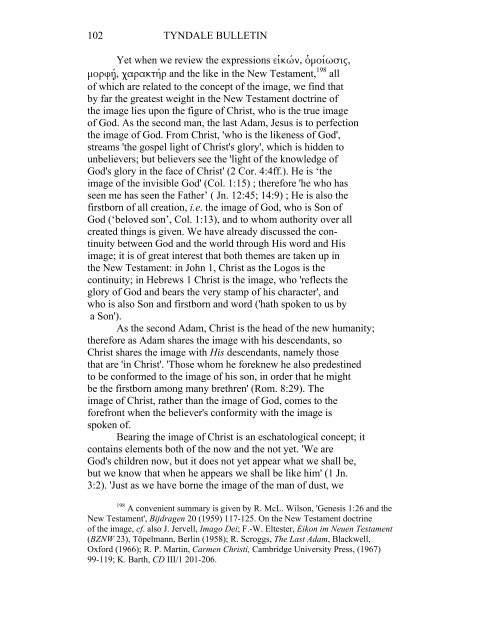THE IMAGE OF GOD IN MAN - Tyndale House
THE IMAGE OF GOD IN MAN - Tyndale House
THE IMAGE OF GOD IN MAN - Tyndale House
- TAGS
- tyndale
- tyndalehouse.com
You also want an ePaper? Increase the reach of your titles
YUMPU automatically turns print PDFs into web optimized ePapers that Google loves.
102 TYNDALE BULLET<strong>IN</strong><br />
Yet when we review the expressions εἱκών, ὁμοίωσις,<br />
μορφῄ, χαρακτήρ and the like in the New Testament, 198 all<br />
of which are related to the concept of the image, we find that<br />
by far the greatest weight in the New Testament doctrine of<br />
the image lies upon the figure of Christ, who is the true image<br />
of God. As the second man, the last Adam, Jesus is to perfection<br />
the image of God. From Christ, 'who is the likeness of God',<br />
streams 'the gospel light of Christ's glory', which is hidden to<br />
unbelievers; but believers see the 'light of the knowledge of<br />
God's glory in the face of Christ' (2 Cor. 4:4ff.). He is ‘the<br />
image of the invisible God' (Col. 1:15) ; therefore 'he who has<br />
seen me has seen the Father’ ( Jn. 12:45; 14:9) ; He is also the<br />
firstborn of all creation, i.e. the image of God, who is Son of<br />
God (‘beloved son’, Col. 1:13), and to whom authority over all<br />
created things is given. We have already discussed the con-<br />
tinuity between God and the world through His word and His<br />
image; it is of great interest that both themes are taken up in<br />
the New Testament: in John 1, Christ as the Logos is the<br />
continuity; in Hebrews 1 Christ is the image, who 'reflects the<br />
glory of God and bears the very stamp of his character', and<br />
who is also Son and firstborn and word ('hath spoken to us by<br />
a Son').<br />
As the second Adam, Christ is the head of the new humanity;<br />
therefore as Adam shares the image with his descendants, so<br />
Christ shares the image with His descendants, namely those<br />
that are 'in Christ'. 'Those whom he foreknew he also predestined<br />
to be conformed to the image of his son, in order that he might<br />
be the firstborn among many brethren' (Rom. 8:29). The<br />
image of Christ, rather than the image of God, comes to the<br />
forefront when the believer's conformity with the image is<br />
spoken of.<br />
Bearing the image of Christ is an eschatological concept; it<br />
contains elements both of the now and the not yet. 'We are<br />
God's children now, but it does not yet appear what we shall be,<br />
but we know that when he appears we shall be like him' (1 Jn.<br />
3:2). 'Just as we have borne the image of the man of dust, we<br />
198 A convenient summary is given by R. McL. Wilson, 'Genesis 1:26 and the<br />
New Testament', Bijdragen 20 (1959) 117-125. On the New Testament doctrine<br />
of the image, cf. also J. Jervell, Imago Dei; F.-W. Eltester, Eikon im Neuen Testament<br />
(BZNW 23), Töpelmann, Berlin (1958); R. Scroggs, The Last Adam, Blackwell,<br />
Oxford (1966); R. P. Martin, Carmen Christi, Cambridge University Press, (1967)<br />
99-119; K. Barth, CD III/1 201-206.

















